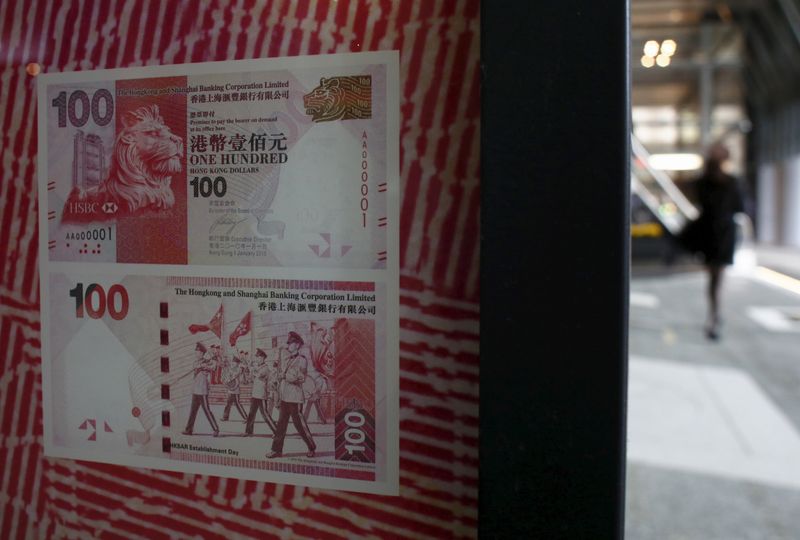Analysis-Why China’s tolerance for a cheaper currency may be temporary
2024.05.09 19:28

SHANGHAI (Reuters) – Currency markets are reading subtle signals from Chinese authorities as an indication they are slowly nudging the yuan lower to regain export competitiveness, but analysts say protracted yuan weakening is neither the intent nor desirable.
The biggest signal of tolerance for a weaker yuan has come via the People’s Bank of China’s (PBOC) daily reference rate, or fixing, around which the yuan is allowed to trade.
Having used the fixing to contain the yuan’s fall from November even as currencies of trade rivals such as Japan and South Korea tumbled, the PBOC’s fixings have since mid-April become less rigid and even slightly biased to weaken the currency.
State-owned Chinese banks, which frequently step into markets to buy the yuan, have also been less conspicuous.
Based on nominal exchange rates, a bit of yuan depreciation makes sense. It has declined about 2% against the dollar this year, but an index of its value against its major trading partners is up nearly 3%, given the sharp 9% drop in the Japanese yen and the Korean won’s 5% drop against the dollar in that period.
“The PBOC will likely continue to allow the yuan to soften modestly against the dollar at the pace that the central bank feels comfortable with,” said Tommy Wu, senior China economist at Commerzbank (ETR:). “This is especially true given that the currencies of China’s trading partners have depreciated against the dollar, which in turn pushed up the yuan currency basket.”
Several global investment banks expect the tightly managed yuan to drop to 7.3 per dollar in the coming months, about 1% weaker than current levels around 7.22.
3rd party Ad. Not an offer or recommendation by Investing.com. See disclosure here or
remove ads
.
That’s a modest decline, reflecting what most analysts suspect is the PBOC’s mindfulness of the risks a weak currency while keeping an eye on trade competitiveness.
“We do not expect to see any significant one-off depreciations, instead a willingness for it to move gradually, and for the currency to weaken, but with lower volatility,” said Nathan Swami, head of currency trading at Citi.
The PBOC did not immediately respond to Reuters request for comments.
UNNECESSARY
There’s little evidence to show the relative strength in the yuan, despite the massive outflows from China’s anaemic markets and economy, is hurting its vast export sector.
New export orders are rising, manufacturing surveys show.
Exports of photovoltaic products, electric vehicles and lithium batteries, dubbed as China’s “three new things” that have replaced traditional labour-intensive household appliances, furniture and clothing exports, have contributed notably.
Their exports totalled 1.06 trillion yuan ($146.7 billion) in 2023, up a third from a year earlier.
A Shanghai-based photovoltaic exporter, who wanted to go only by her family name Zhu, says her business has not been squeezed by Korean and Japanese products becoming cheaper.
“For some products, Chinese brands have dominated the market. It is hard for Japanese and Korean brands to squeeze in … Currency fluctuation is certainly an important factor, but I don’t see huge impact yet,” Zhu said.
Chinese manufacturers are also seeing their costs falling thanks to deflationary forces from weak consumption and investment at home.
Adjusted for inflation, the yuan is at its weakest since the 2008 global financial crisis, according to Goldman Sachs’ estimates.
3rd party Ad. Not an offer or recommendation by Investing.com. See disclosure here or
remove ads
.
China’s consumer inflation has hovered at nearly zero over the past year.
“That alone confers a degree of competitiveness,” said Frederic Neumann, chief Asia economist at HSBC. “So even if the currency went to 7 (to the dollar), they would still be probably more competitive on a two- or three-year basis.”
On the flipside, the terms of trade have turned against China as prices of oil and other commodities it imports stay high.
Neumann says a bit of currency depreciation could be part of Beijing’s policy toolkit to raise prices of manufacturing inputs and give exporters a bit of extra incentive.
But too much risks hurting consumers already scarred by the collapse in property and stock markets. Per capita spending during the Labour Day holiday is down 11.5% from pre-COVID levels in 2019, according Reuters calculations based on official data.
China’s dominance as an exporter is another worry.
“The problem in China’s case is that, if they depreciate the currency now, they risk leading to global backlash. They’re already facing a lot of other countries complaining about China’s increasing competitiveness,” said HSBC’s Neumann.
“If you depreciate the currency a little bit, maybe you can help export margins a bit, but you’re not going to raise your export volumes that much. So there’s a limited there’s less of a benefit from a depreciation here than for a small country.”
($1 = 7.2258 )








